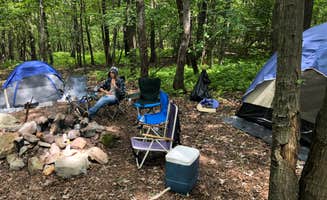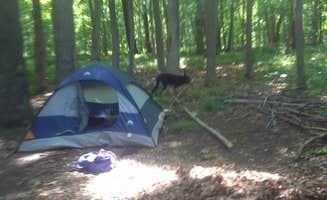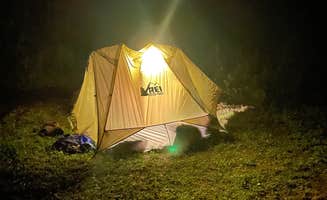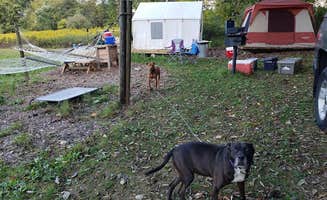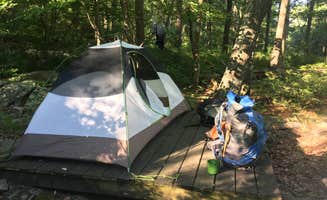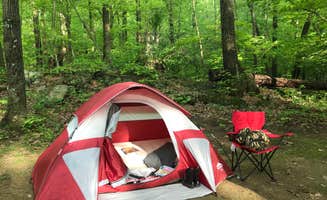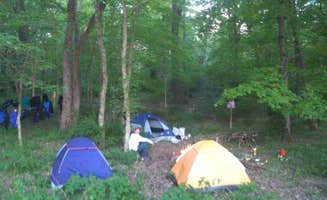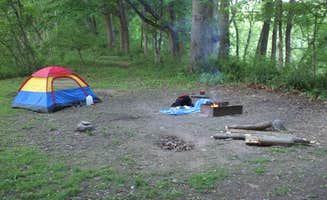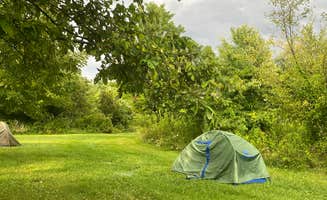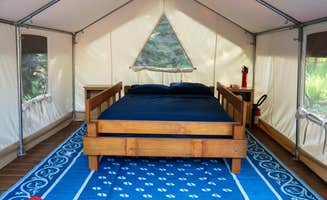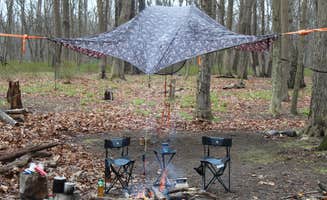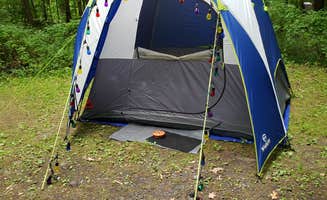Tent camping in Delaware Water Gap, Pennsylvania offers access to over 70,000 acres of protected lands along the Delaware River. The region's elevation ranges from 280 feet at river level to over 1,600 feet at the ridge tops, creating varied camping microclimates. Winter overnight temperatures can drop below 20°F, while summer days often exceed 90°F with high humidity levels.
What to do
Blueberry picking at Catfish Pond: During summer months, Camp Mohican Outdoor Center visitors can harvest wild blueberries around the lake. According to a camper, "If you're there in the summer, I'd recommend taking a kayak around the lake and filling it with wild blueberries. Lots of hiking options as well." Camp Mohican Outdoor Center offers kayak and canoe rentals for easy access to berry patches.
Hike Cushetunk Mountain: Round Valley State Park provides direct trail access from campsites to this prominent ridge. A reviewer notes, "The hike up in the cushetunk mountain is really nice as well. If you're looking for a getaway without doing backcountry planning this is the place." Round Valley State Park requires a 3-6 mile hike to reach campsites unless boating in.
Fish from riverside campsites: Multiple locations offer direct fishing access from tent sites. As one camper reported, "As dusk fell, a small group of local fishermen came walking through the camp to access the river. It turns out the locals know this place well and it is very popular with the anglers." Walter's Boat In Campsites provides excellent river fishing opportunities without needing to leave your camp.
What campers like
Privacy between sites: Many Delaware Water Gap tent sites offer significant separation from neighbors. A Jenny Jump camper explained, "The space was reasonably priced, but we did have to pay an extra $5/day for our dog. However, we didn't mind as it was so private we felt like we had the entire Park to ourselves." Jenny Jump State Forest features spacious sites with natural screening between camping areas.
Boat-in camping seclusion: Several riverside locations can only be accessed via water travel. A visitor to Bushkill Creek noted, "Great to have no neighbors, though we could hear some noise across the water from the 6 Peters sites on the other side. No privy that we found, but a good fire ring and plenty of space for tents." Bushkill Creek Campsite offers a single site on the Pennsylvania side of Zone 4.
Elevated mountain views: Multiple tent campgrounds provide ridge-top perspectives. According to a Kirkridge Shelter visitor, "This spot is right next to a beautiful view on the side of Kittany Mountain and just off the Appalachian trail. There is 4 spots to set up at all of which have a spot for a fire." Kirkridge campers can choose between wooded or open view sites.
What you should know
Water sources vary greatly: Some campgrounds have reliable potable water, while others require filtration. One Round Valley camper shared, "There's bathrooms and pumps but we just filtered the water from the reservoir instead which tasted a million times better than the well water." At Rivers Bend Group Campground, a visitor reported, "A pump well that did not work. Quiet surrounding."
Fire restrictions and availability: While most tent sites include fire rings, regulations and firewood access differ. A Jenny Jump reviewer cautioned, "The only problem we encountered was that there wasn't a store close by for ice or other essentials, although the main office does sell firewood. They close at 4pm, though, so be sure to get there before then!"
Highway noise impacts some sites: Despite natural settings, road sounds can reach certain campgrounds. A camper observed, "This campground is a nice little hideaway not too far from the beaten path. You can hear some of the highway sounds from the campsites (especially the jake brake)." Another noted, "This park is high up on a mountain and affords lovely views. My only complaint is that the noise from the highway was quite loud at night."
Tips for camping with families
Beginner-friendly options: Several locations cater to first-time campers or those with children. A visitor to Jenny Jump shared, "I was looking forward to a Worthington State Park campgrounds visit but that day they were all packed and I was suggested to Jenny Jump State. I enjoyed the overnight camp out with my kids and they had a blast. Nice size primitive tent site we had and was nice for beginner camping."
Wildlife viewing opportunities: Many campsites offer chances to observe animals. At Camp Starry Night, a camper reported, "Although you did get a nice view of the steer and sheep in the next field while watching the fire I think it would have been much better to put the pit out in front of the tent and hammocks instead of off to the side."
Reserve well in advance: Popular family-friendly sites fill quickly, especially during summer. A Camp Mohican visitor advised, "There is also specific areas for group camping but always good idea to reserve in advance to make sure you can lock it down." Summer weekend availability can disappear 3-4 months in advance at most established campgrounds.
Tips from RVers
Limited RV options: Tent camping dominates Delaware Water Gap, with few true RV-friendly sites. At Jenny Jump, a camper noted, "This campground is a nice little hideaway not too far from the beaten path. The sites are hit or miss in terms of comfort, some have large, flat, clear spaces for multiple tents, some you have to wedge a tent to avoid rocks." Most sites lack hookups or adequate turning radius for larger vehicles.


